Analysis of Tesla's Corporate Strategy: A Comprehensive Report
VerifiedAdded on 2021/02/21
|12
|3933
|119
Report
AI Summary
This report provides a comprehensive analysis of Tesla's corporate strategy. It begins with an introduction to corporate strategy and then delves into a PESTLE analysis, examining the political, economic, social, technological, legal, and environmental factors impacting Tesla's operations. The report then applies Porter's Five Forces model to assess the competitive intensity within the electric vehicle market. Following this, a SWOT analysis is conducted to evaluate Tesla's internal strengths and weaknesses, as well as external opportunities and threats. The VRIO analysis is subsequently employed to determine Tesla's sustainable competitive advantages. The report concludes with a discussion of the SAFe criteria, offering a holistic view of Tesla's strategic positioning and business model. The assignment thoroughly examines various aspects of Tesla's operations, from market dynamics to internal capabilities, to offer a detailed understanding of its strategic approach.
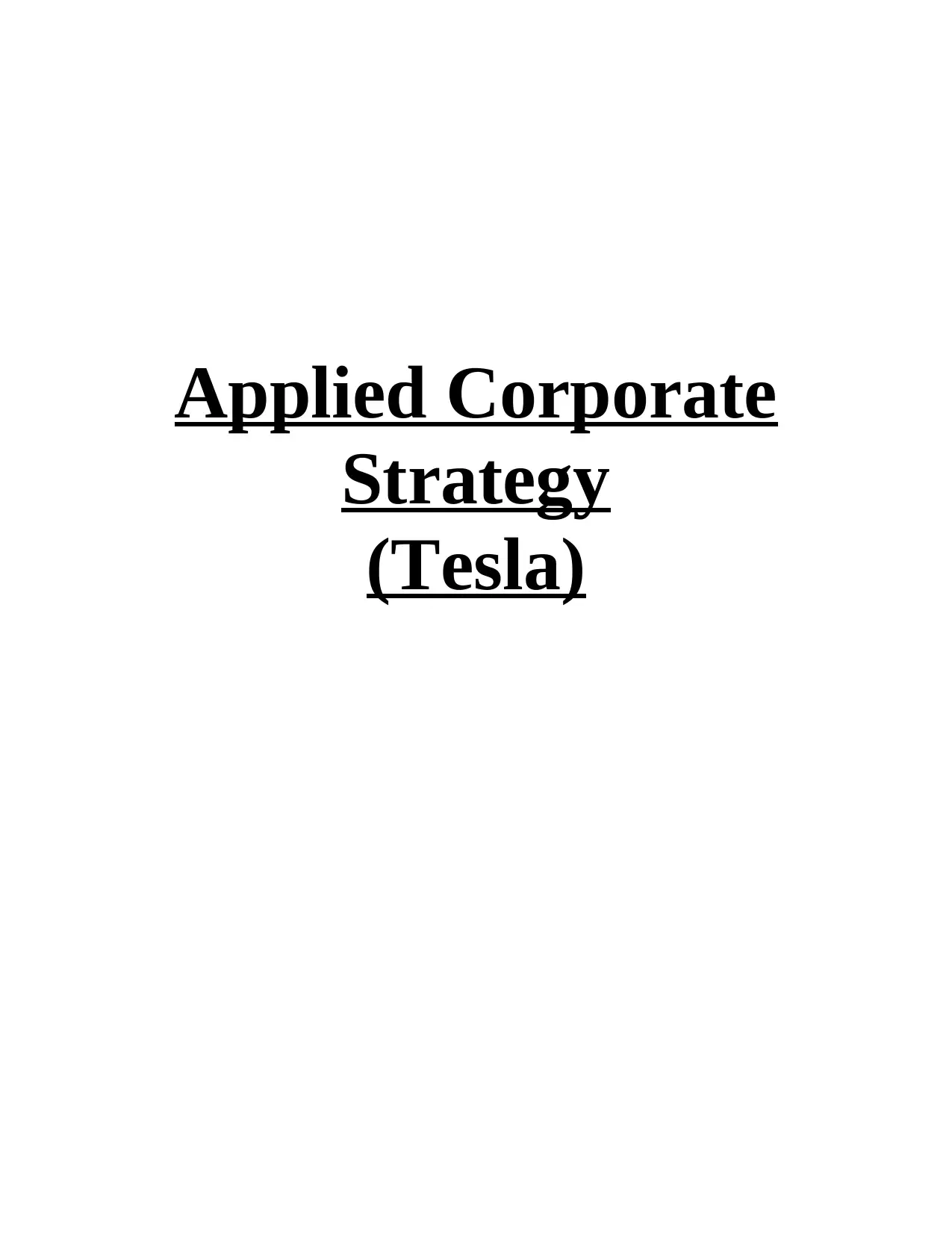
Applied Corporate
Strategy
(Tesla)
Strategy
(Tesla)
Paraphrase This Document
Need a fresh take? Get an instant paraphrase of this document with our AI Paraphraser
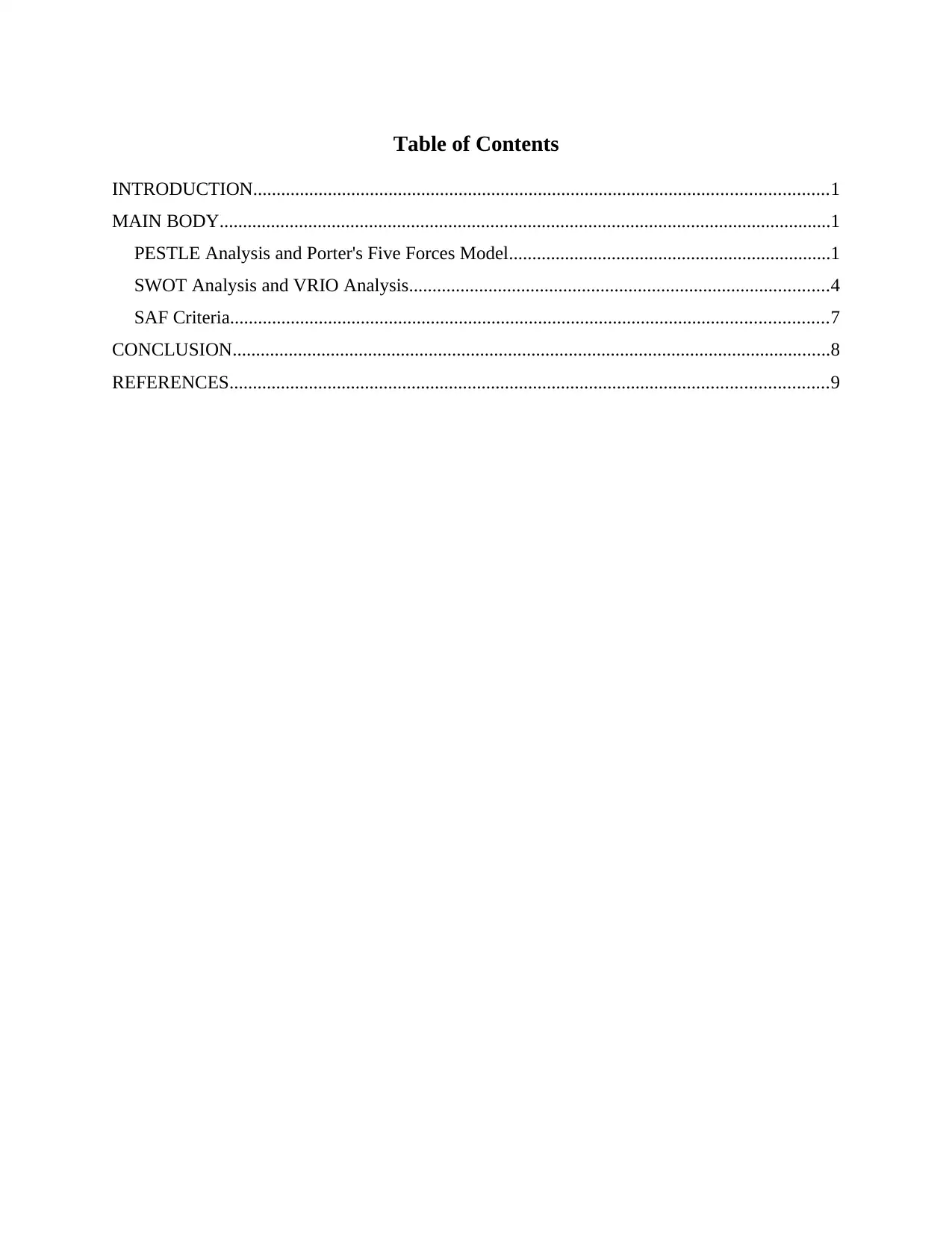
Table of Contents
INTRODUCTION...........................................................................................................................1
MAIN BODY...................................................................................................................................1
PESTLE Analysis and Porter's Five Forces Model.....................................................................1
SWOT Analysis and VRIO Analysis..........................................................................................4
SAF Criteria................................................................................................................................7
CONCLUSION................................................................................................................................8
REFERENCES................................................................................................................................9
INTRODUCTION...........................................................................................................................1
MAIN BODY...................................................................................................................................1
PESTLE Analysis and Porter's Five Forces Model.....................................................................1
SWOT Analysis and VRIO Analysis..........................................................................................4
SAF Criteria................................................................................................................................7
CONCLUSION................................................................................................................................8
REFERENCES................................................................................................................................9
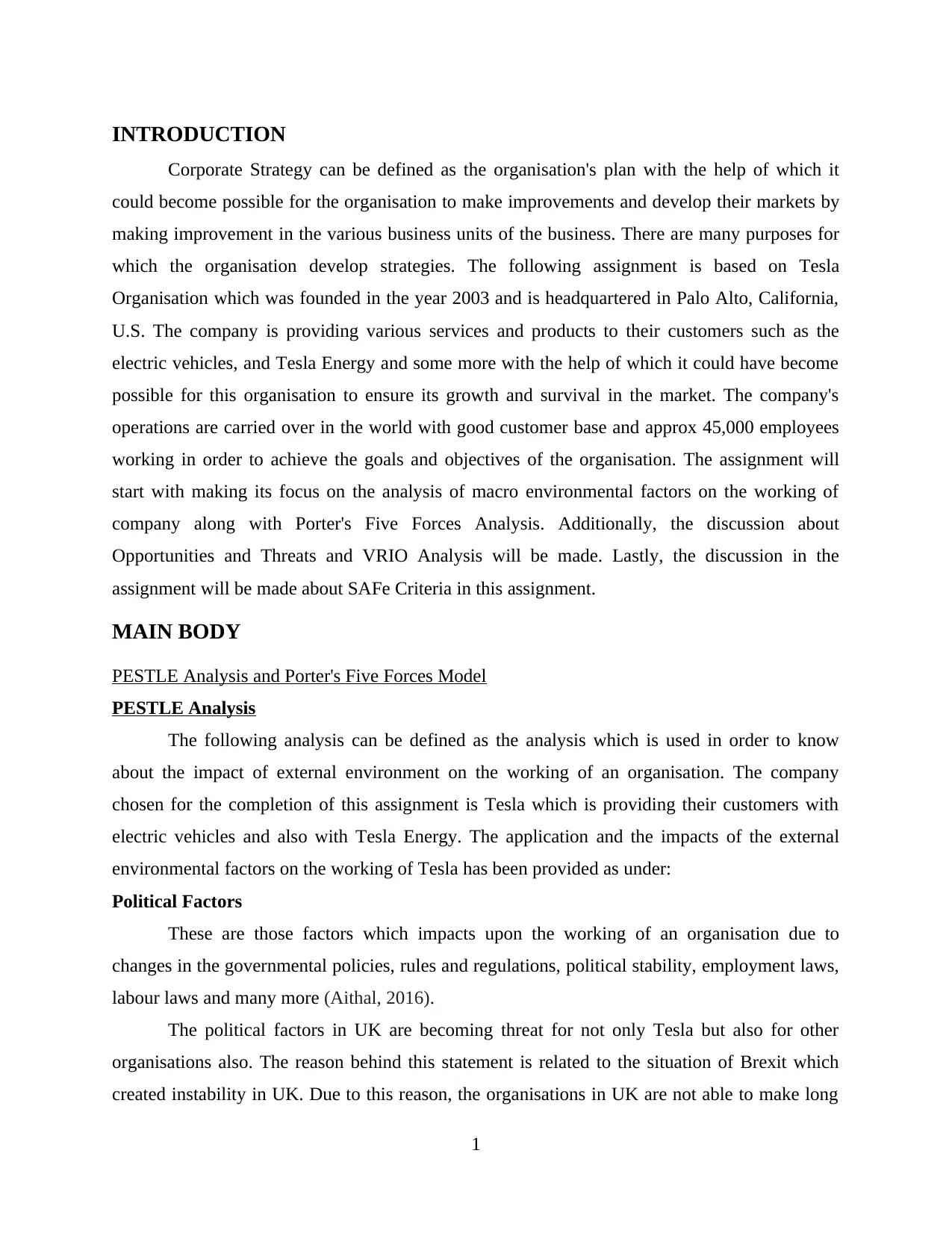
INTRODUCTION
Corporate Strategy can be defined as the organisation's plan with the help of which it
could become possible for the organisation to make improvements and develop their markets by
making improvement in the various business units of the business. There are many purposes for
which the organisation develop strategies. The following assignment is based on Tesla
Organisation which was founded in the year 2003 and is headquartered in Palo Alto, California,
U.S. The company is providing various services and products to their customers such as the
electric vehicles, and Tesla Energy and some more with the help of which it could have become
possible for this organisation to ensure its growth and survival in the market. The company's
operations are carried over in the world with good customer base and approx 45,000 employees
working in order to achieve the goals and objectives of the organisation. The assignment will
start with making its focus on the analysis of macro environmental factors on the working of
company along with Porter's Five Forces Analysis. Additionally, the discussion about
Opportunities and Threats and VRIO Analysis will be made. Lastly, the discussion in the
assignment will be made about SAFe Criteria in this assignment.
MAIN BODY
PESTLE Analysis and Porter's Five Forces Model
PESTLE Analysis
The following analysis can be defined as the analysis which is used in order to know
about the impact of external environment on the working of an organisation. The company
chosen for the completion of this assignment is Tesla which is providing their customers with
electric vehicles and also with Tesla Energy. The application and the impacts of the external
environmental factors on the working of Tesla has been provided as under:
Political Factors
These are those factors which impacts upon the working of an organisation due to
changes in the governmental policies, rules and regulations, political stability, employment laws,
labour laws and many more (Aithal, 2016).
The political factors in UK are becoming threat for not only Tesla but also for other
organisations also. The reason behind this statement is related to the situation of Brexit which
created instability in UK. Due to this reason, the organisations in UK are not able to make long
1
Corporate Strategy can be defined as the organisation's plan with the help of which it
could become possible for the organisation to make improvements and develop their markets by
making improvement in the various business units of the business. There are many purposes for
which the organisation develop strategies. The following assignment is based on Tesla
Organisation which was founded in the year 2003 and is headquartered in Palo Alto, California,
U.S. The company is providing various services and products to their customers such as the
electric vehicles, and Tesla Energy and some more with the help of which it could have become
possible for this organisation to ensure its growth and survival in the market. The company's
operations are carried over in the world with good customer base and approx 45,000 employees
working in order to achieve the goals and objectives of the organisation. The assignment will
start with making its focus on the analysis of macro environmental factors on the working of
company along with Porter's Five Forces Analysis. Additionally, the discussion about
Opportunities and Threats and VRIO Analysis will be made. Lastly, the discussion in the
assignment will be made about SAFe Criteria in this assignment.
MAIN BODY
PESTLE Analysis and Porter's Five Forces Model
PESTLE Analysis
The following analysis can be defined as the analysis which is used in order to know
about the impact of external environment on the working of an organisation. The company
chosen for the completion of this assignment is Tesla which is providing their customers with
electric vehicles and also with Tesla Energy. The application and the impacts of the external
environmental factors on the working of Tesla has been provided as under:
Political Factors
These are those factors which impacts upon the working of an organisation due to
changes in the governmental policies, rules and regulations, political stability, employment laws,
labour laws and many more (Aithal, 2016).
The political factors in UK are becoming threat for not only Tesla but also for other
organisations also. The reason behind this statement is related to the situation of Brexit which
created instability in UK. Due to this reason, the organisations in UK are not able to make long
1
⊘ This is a preview!⊘
Do you want full access?
Subscribe today to unlock all pages.

Trusted by 1+ million students worldwide
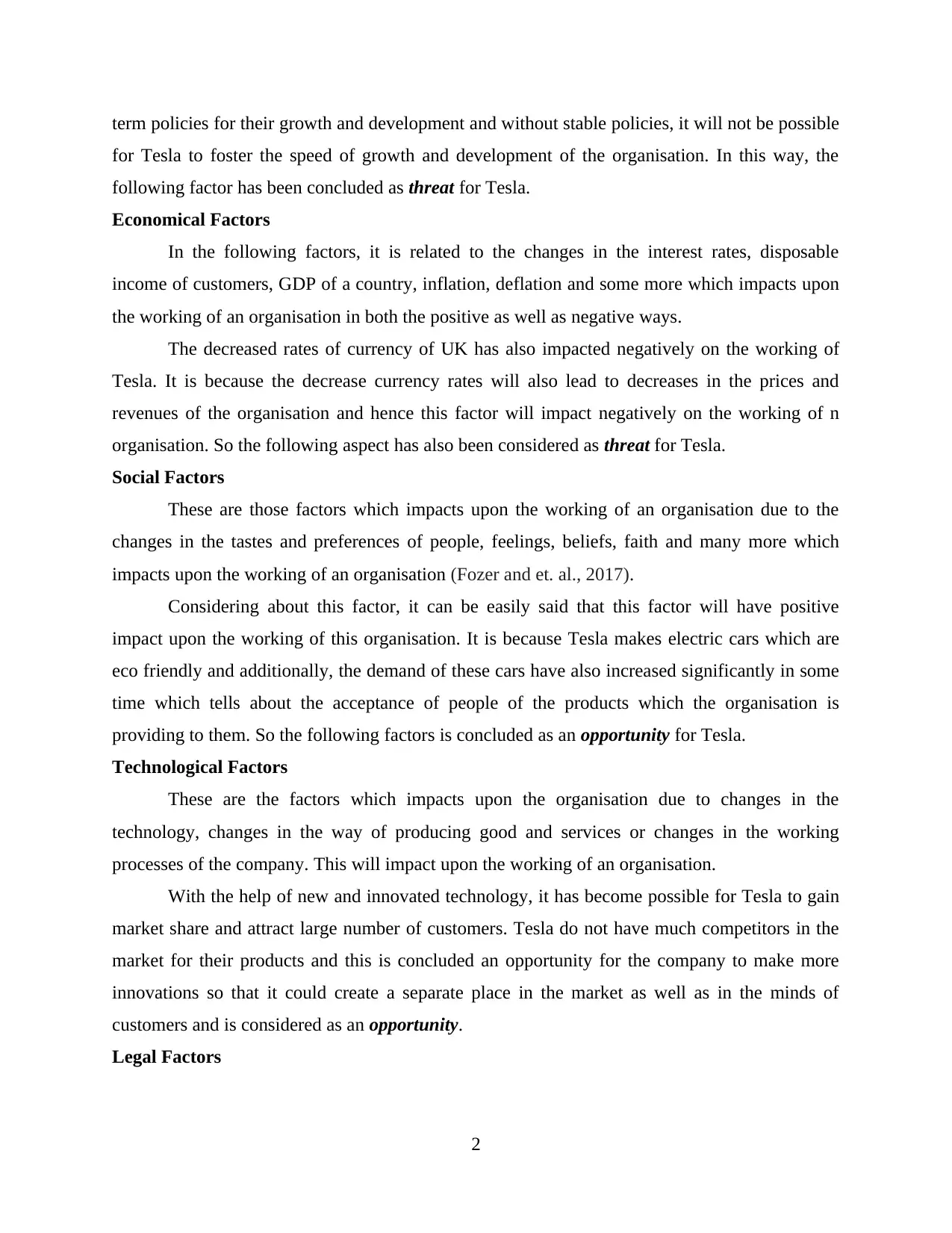
term policies for their growth and development and without stable policies, it will not be possible
for Tesla to foster the speed of growth and development of the organisation. In this way, the
following factor has been concluded as threat for Tesla.
Economical Factors
In the following factors, it is related to the changes in the interest rates, disposable
income of customers, GDP of a country, inflation, deflation and some more which impacts upon
the working of an organisation in both the positive as well as negative ways.
The decreased rates of currency of UK has also impacted negatively on the working of
Tesla. It is because the decrease currency rates will also lead to decreases in the prices and
revenues of the organisation and hence this factor will impact negatively on the working of n
organisation. So the following aspect has also been considered as threat for Tesla.
Social Factors
These are those factors which impacts upon the working of an organisation due to the
changes in the tastes and preferences of people, feelings, beliefs, faith and many more which
impacts upon the working of an organisation (Fozer and et. al., 2017).
Considering about this factor, it can be easily said that this factor will have positive
impact upon the working of this organisation. It is because Tesla makes electric cars which are
eco friendly and additionally, the demand of these cars have also increased significantly in some
time which tells about the acceptance of people of the products which the organisation is
providing to them. So the following factors is concluded as an opportunity for Tesla.
Technological Factors
These are the factors which impacts upon the organisation due to changes in the
technology, changes in the way of producing good and services or changes in the working
processes of the company. This will impact upon the working of an organisation.
With the help of new and innovated technology, it has become possible for Tesla to gain
market share and attract large number of customers. Tesla do not have much competitors in the
market for their products and this is concluded an opportunity for the company to make more
innovations so that it could create a separate place in the market as well as in the minds of
customers and is considered as an opportunity.
Legal Factors
2
for Tesla to foster the speed of growth and development of the organisation. In this way, the
following factor has been concluded as threat for Tesla.
Economical Factors
In the following factors, it is related to the changes in the interest rates, disposable
income of customers, GDP of a country, inflation, deflation and some more which impacts upon
the working of an organisation in both the positive as well as negative ways.
The decreased rates of currency of UK has also impacted negatively on the working of
Tesla. It is because the decrease currency rates will also lead to decreases in the prices and
revenues of the organisation and hence this factor will impact negatively on the working of n
organisation. So the following aspect has also been considered as threat for Tesla.
Social Factors
These are those factors which impacts upon the working of an organisation due to the
changes in the tastes and preferences of people, feelings, beliefs, faith and many more which
impacts upon the working of an organisation (Fozer and et. al., 2017).
Considering about this factor, it can be easily said that this factor will have positive
impact upon the working of this organisation. It is because Tesla makes electric cars which are
eco friendly and additionally, the demand of these cars have also increased significantly in some
time which tells about the acceptance of people of the products which the organisation is
providing to them. So the following factors is concluded as an opportunity for Tesla.
Technological Factors
These are the factors which impacts upon the organisation due to changes in the
technology, changes in the way of producing good and services or changes in the working
processes of the company. This will impact upon the working of an organisation.
With the help of new and innovated technology, it has become possible for Tesla to gain
market share and attract large number of customers. Tesla do not have much competitors in the
market for their products and this is concluded an opportunity for the company to make more
innovations so that it could create a separate place in the market as well as in the minds of
customers and is considered as an opportunity.
Legal Factors
2
Paraphrase This Document
Need a fresh take? Get an instant paraphrase of this document with our AI Paraphraser
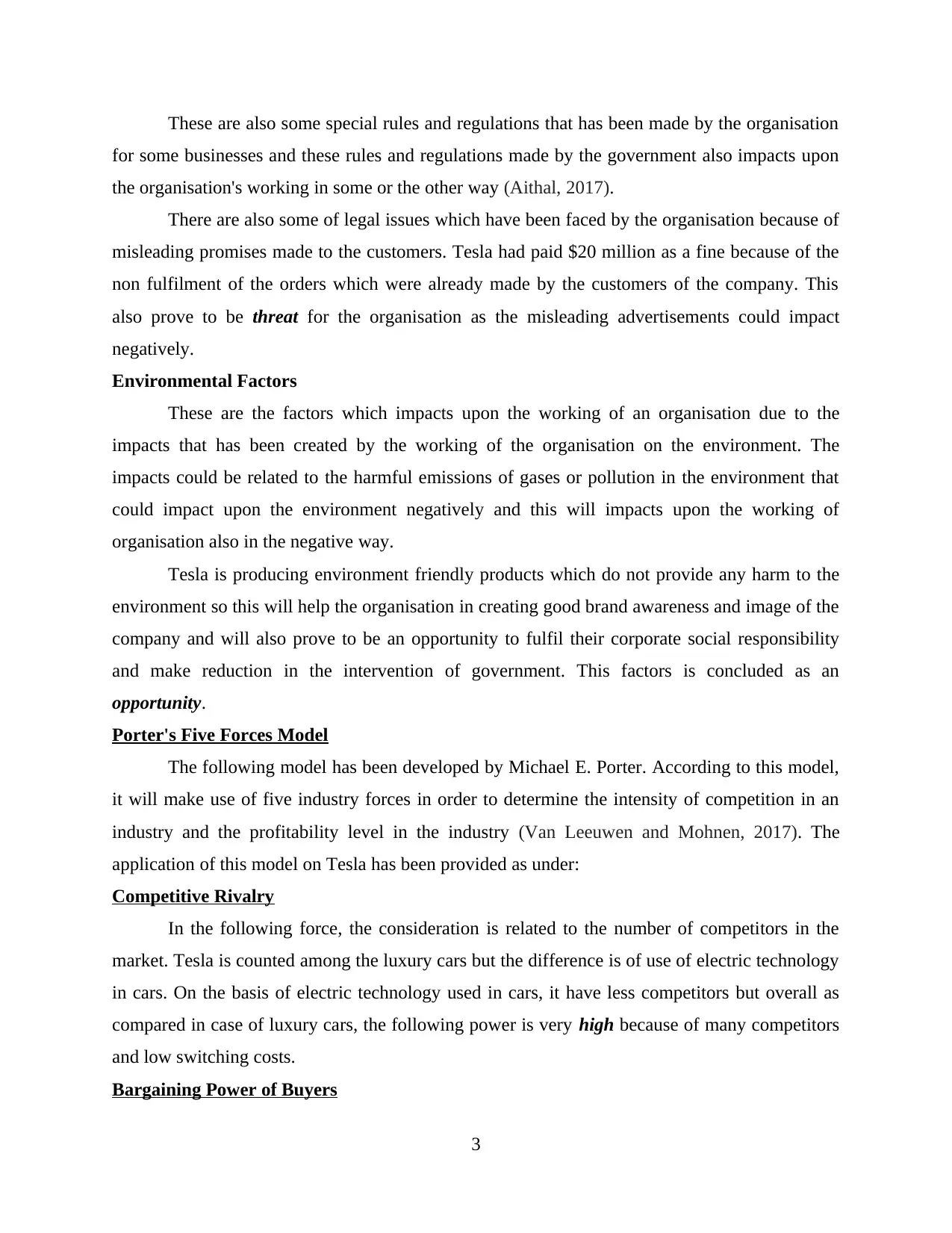
These are also some special rules and regulations that has been made by the organisation
for some businesses and these rules and regulations made by the government also impacts upon
the organisation's working in some or the other way (Aithal, 2017).
There are also some of legal issues which have been faced by the organisation because of
misleading promises made to the customers. Tesla had paid $20 million as a fine because of the
non fulfilment of the orders which were already made by the customers of the company. This
also prove to be threat for the organisation as the misleading advertisements could impact
negatively.
Environmental Factors
These are the factors which impacts upon the working of an organisation due to the
impacts that has been created by the working of the organisation on the environment. The
impacts could be related to the harmful emissions of gases or pollution in the environment that
could impact upon the environment negatively and this will impacts upon the working of
organisation also in the negative way.
Tesla is producing environment friendly products which do not provide any harm to the
environment so this will help the organisation in creating good brand awareness and image of the
company and will also prove to be an opportunity to fulfil their corporate social responsibility
and make reduction in the intervention of government. This factors is concluded as an
opportunity.
Porter's Five Forces Model
The following model has been developed by Michael E. Porter. According to this model,
it will make use of five industry forces in order to determine the intensity of competition in an
industry and the profitability level in the industry (Van Leeuwen and Mohnen, 2017). The
application of this model on Tesla has been provided as under:
Competitive Rivalry
In the following force, the consideration is related to the number of competitors in the
market. Tesla is counted among the luxury cars but the difference is of use of electric technology
in cars. On the basis of electric technology used in cars, it have less competitors but overall as
compared in case of luxury cars, the following power is very high because of many competitors
and low switching costs.
Bargaining Power of Buyers
3
for some businesses and these rules and regulations made by the government also impacts upon
the organisation's working in some or the other way (Aithal, 2017).
There are also some of legal issues which have been faced by the organisation because of
misleading promises made to the customers. Tesla had paid $20 million as a fine because of the
non fulfilment of the orders which were already made by the customers of the company. This
also prove to be threat for the organisation as the misleading advertisements could impact
negatively.
Environmental Factors
These are the factors which impacts upon the working of an organisation due to the
impacts that has been created by the working of the organisation on the environment. The
impacts could be related to the harmful emissions of gases or pollution in the environment that
could impact upon the environment negatively and this will impacts upon the working of
organisation also in the negative way.
Tesla is producing environment friendly products which do not provide any harm to the
environment so this will help the organisation in creating good brand awareness and image of the
company and will also prove to be an opportunity to fulfil their corporate social responsibility
and make reduction in the intervention of government. This factors is concluded as an
opportunity.
Porter's Five Forces Model
The following model has been developed by Michael E. Porter. According to this model,
it will make use of five industry forces in order to determine the intensity of competition in an
industry and the profitability level in the industry (Van Leeuwen and Mohnen, 2017). The
application of this model on Tesla has been provided as under:
Competitive Rivalry
In the following force, the consideration is related to the number of competitors in the
market. Tesla is counted among the luxury cars but the difference is of use of electric technology
in cars. On the basis of electric technology used in cars, it have less competitors but overall as
compared in case of luxury cars, the following power is very high because of many competitors
and low switching costs.
Bargaining Power of Buyers
3
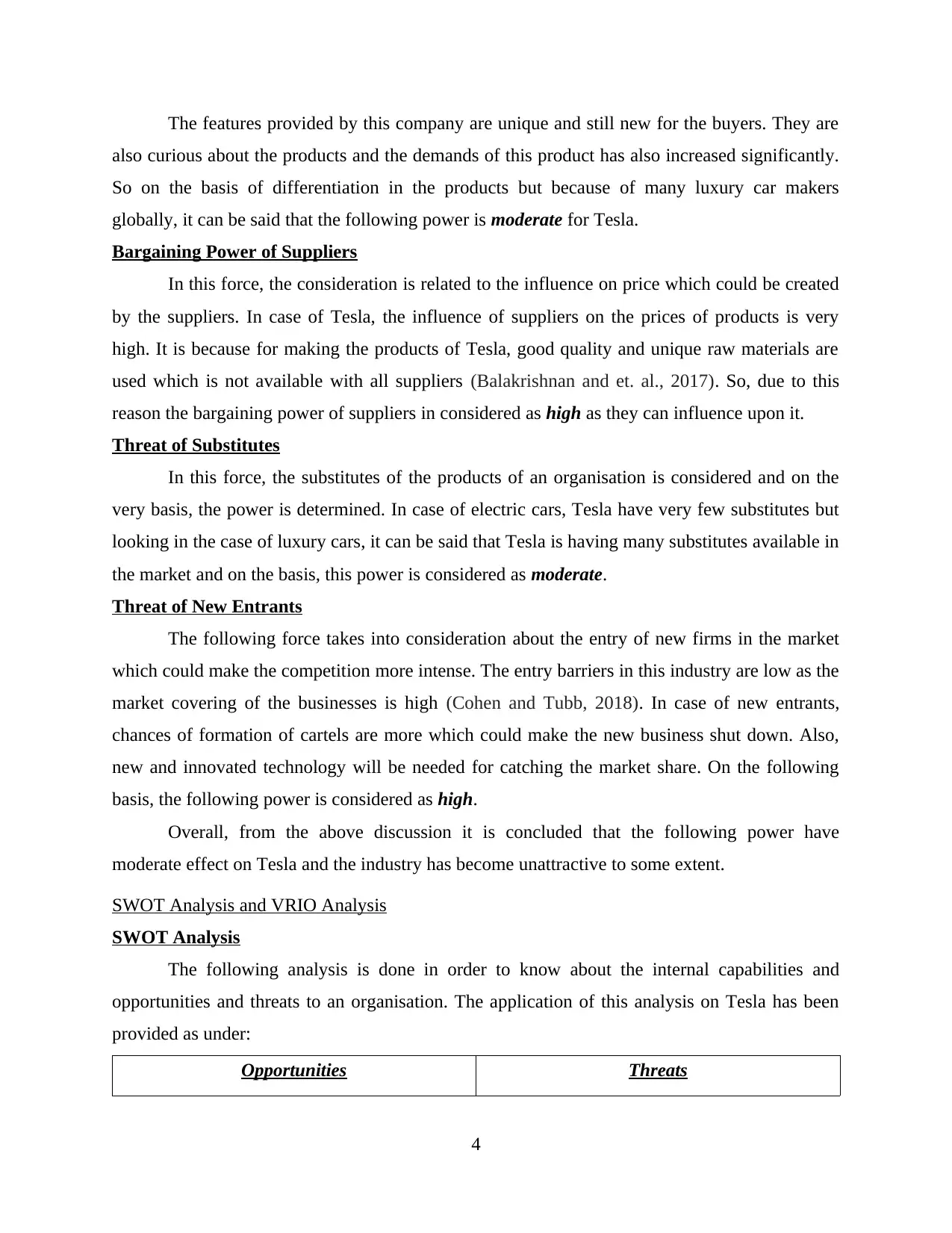
The features provided by this company are unique and still new for the buyers. They are
also curious about the products and the demands of this product has also increased significantly.
So on the basis of differentiation in the products but because of many luxury car makers
globally, it can be said that the following power is moderate for Tesla.
Bargaining Power of Suppliers
In this force, the consideration is related to the influence on price which could be created
by the suppliers. In case of Tesla, the influence of suppliers on the prices of products is very
high. It is because for making the products of Tesla, good quality and unique raw materials are
used which is not available with all suppliers (Balakrishnan and et. al., 2017). So, due to this
reason the bargaining power of suppliers in considered as high as they can influence upon it.
Threat of Substitutes
In this force, the substitutes of the products of an organisation is considered and on the
very basis, the power is determined. In case of electric cars, Tesla have very few substitutes but
looking in the case of luxury cars, it can be said that Tesla is having many substitutes available in
the market and on the basis, this power is considered as moderate.
Threat of New Entrants
The following force takes into consideration about the entry of new firms in the market
which could make the competition more intense. The entry barriers in this industry are low as the
market covering of the businesses is high (Cohen and Tubb, 2018). In case of new entrants,
chances of formation of cartels are more which could make the new business shut down. Also,
new and innovated technology will be needed for catching the market share. On the following
basis, the following power is considered as high.
Overall, from the above discussion it is concluded that the following power have
moderate effect on Tesla and the industry has become unattractive to some extent.
SWOT Analysis and VRIO Analysis
SWOT Analysis
The following analysis is done in order to know about the internal capabilities and
opportunities and threats to an organisation. The application of this analysis on Tesla has been
provided as under:
Opportunities Threats
4
also curious about the products and the demands of this product has also increased significantly.
So on the basis of differentiation in the products but because of many luxury car makers
globally, it can be said that the following power is moderate for Tesla.
Bargaining Power of Suppliers
In this force, the consideration is related to the influence on price which could be created
by the suppliers. In case of Tesla, the influence of suppliers on the prices of products is very
high. It is because for making the products of Tesla, good quality and unique raw materials are
used which is not available with all suppliers (Balakrishnan and et. al., 2017). So, due to this
reason the bargaining power of suppliers in considered as high as they can influence upon it.
Threat of Substitutes
In this force, the substitutes of the products of an organisation is considered and on the
very basis, the power is determined. In case of electric cars, Tesla have very few substitutes but
looking in the case of luxury cars, it can be said that Tesla is having many substitutes available in
the market and on the basis, this power is considered as moderate.
Threat of New Entrants
The following force takes into consideration about the entry of new firms in the market
which could make the competition more intense. The entry barriers in this industry are low as the
market covering of the businesses is high (Cohen and Tubb, 2018). In case of new entrants,
chances of formation of cartels are more which could make the new business shut down. Also,
new and innovated technology will be needed for catching the market share. On the following
basis, the following power is considered as high.
Overall, from the above discussion it is concluded that the following power have
moderate effect on Tesla and the industry has become unattractive to some extent.
SWOT Analysis and VRIO Analysis
SWOT Analysis
The following analysis is done in order to know about the internal capabilities and
opportunities and threats to an organisation. The application of this analysis on Tesla has been
provided as under:
Opportunities Threats
4
⊘ This is a preview!⊘
Do you want full access?
Subscribe today to unlock all pages.

Trusted by 1+ million students worldwide
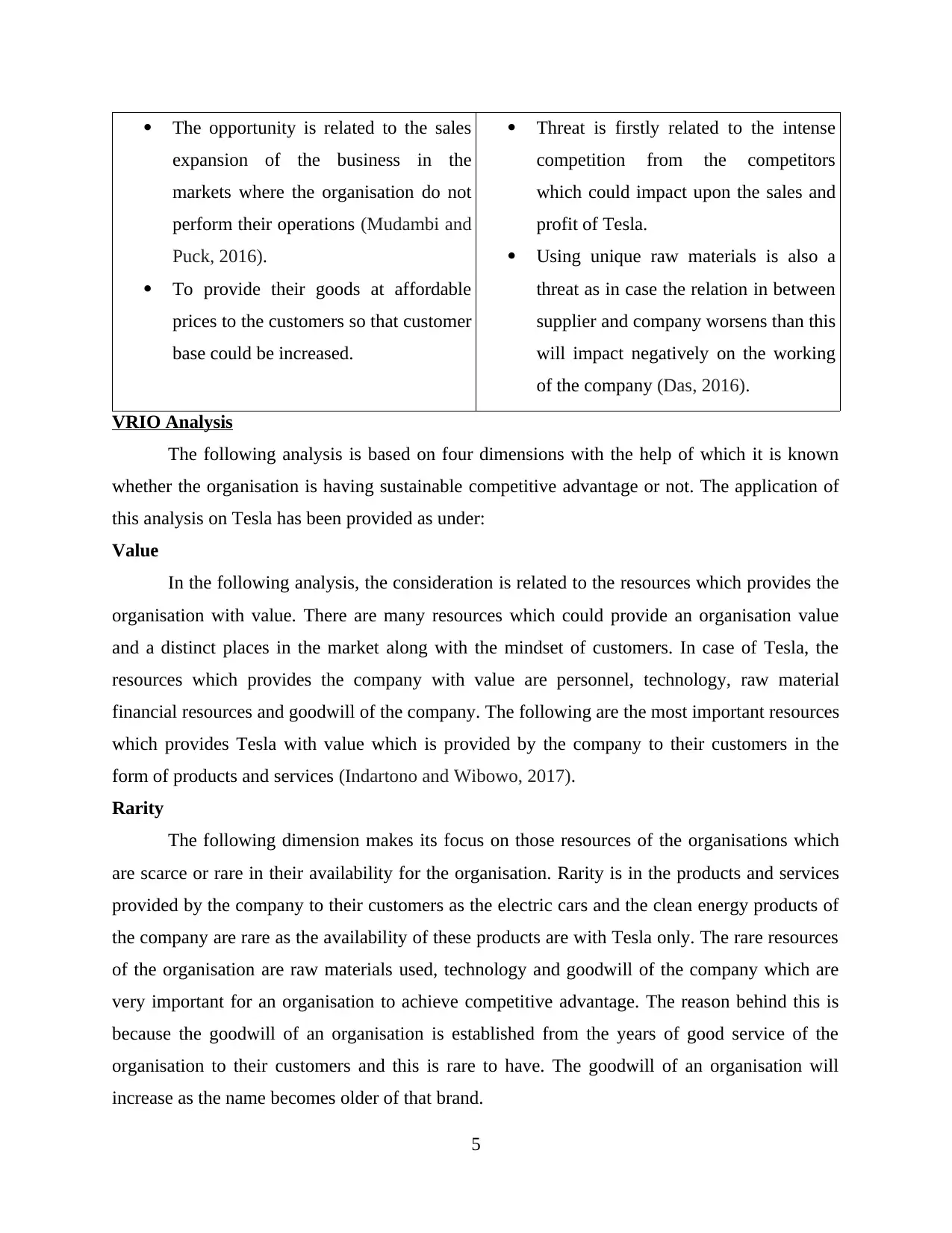
The opportunity is related to the sales
expansion of the business in the
markets where the organisation do not
perform their operations (Mudambi and
Puck, 2016).
To provide their goods at affordable
prices to the customers so that customer
base could be increased.
Threat is firstly related to the intense
competition from the competitors
which could impact upon the sales and
profit of Tesla.
Using unique raw materials is also a
threat as in case the relation in between
supplier and company worsens than this
will impact negatively on the working
of the company (Das, 2016).
VRIO Analysis
The following analysis is based on four dimensions with the help of which it is known
whether the organisation is having sustainable competitive advantage or not. The application of
this analysis on Tesla has been provided as under:
Value
In the following analysis, the consideration is related to the resources which provides the
organisation with value. There are many resources which could provide an organisation value
and a distinct places in the market along with the mindset of customers. In case of Tesla, the
resources which provides the company with value are personnel, technology, raw material
financial resources and goodwill of the company. The following are the most important resources
which provides Tesla with value which is provided by the company to their customers in the
form of products and services (Indartono and Wibowo, 2017).
Rarity
The following dimension makes its focus on those resources of the organisations which
are scarce or rare in their availability for the organisation. Rarity is in the products and services
provided by the company to their customers as the electric cars and the clean energy products of
the company are rare as the availability of these products are with Tesla only. The rare resources
of the organisation are raw materials used, technology and goodwill of the company which are
very important for an organisation to achieve competitive advantage. The reason behind this is
because the goodwill of an organisation is established from the years of good service of the
organisation to their customers and this is rare to have. The goodwill of an organisation will
increase as the name becomes older of that brand.
5
expansion of the business in the
markets where the organisation do not
perform their operations (Mudambi and
Puck, 2016).
To provide their goods at affordable
prices to the customers so that customer
base could be increased.
Threat is firstly related to the intense
competition from the competitors
which could impact upon the sales and
profit of Tesla.
Using unique raw materials is also a
threat as in case the relation in between
supplier and company worsens than this
will impact negatively on the working
of the company (Das, 2016).
VRIO Analysis
The following analysis is based on four dimensions with the help of which it is known
whether the organisation is having sustainable competitive advantage or not. The application of
this analysis on Tesla has been provided as under:
Value
In the following analysis, the consideration is related to the resources which provides the
organisation with value. There are many resources which could provide an organisation value
and a distinct places in the market along with the mindset of customers. In case of Tesla, the
resources which provides the company with value are personnel, technology, raw material
financial resources and goodwill of the company. The following are the most important resources
which provides Tesla with value which is provided by the company to their customers in the
form of products and services (Indartono and Wibowo, 2017).
Rarity
The following dimension makes its focus on those resources of the organisations which
are scarce or rare in their availability for the organisation. Rarity is in the products and services
provided by the company to their customers as the electric cars and the clean energy products of
the company are rare as the availability of these products are with Tesla only. The rare resources
of the organisation are raw materials used, technology and goodwill of the company which are
very important for an organisation to achieve competitive advantage. The reason behind this is
because the goodwill of an organisation is established from the years of good service of the
organisation to their customers and this is rare to have. The goodwill of an organisation will
increase as the name becomes older of that brand.
5
Paraphrase This Document
Need a fresh take? Get an instant paraphrase of this document with our AI Paraphraser
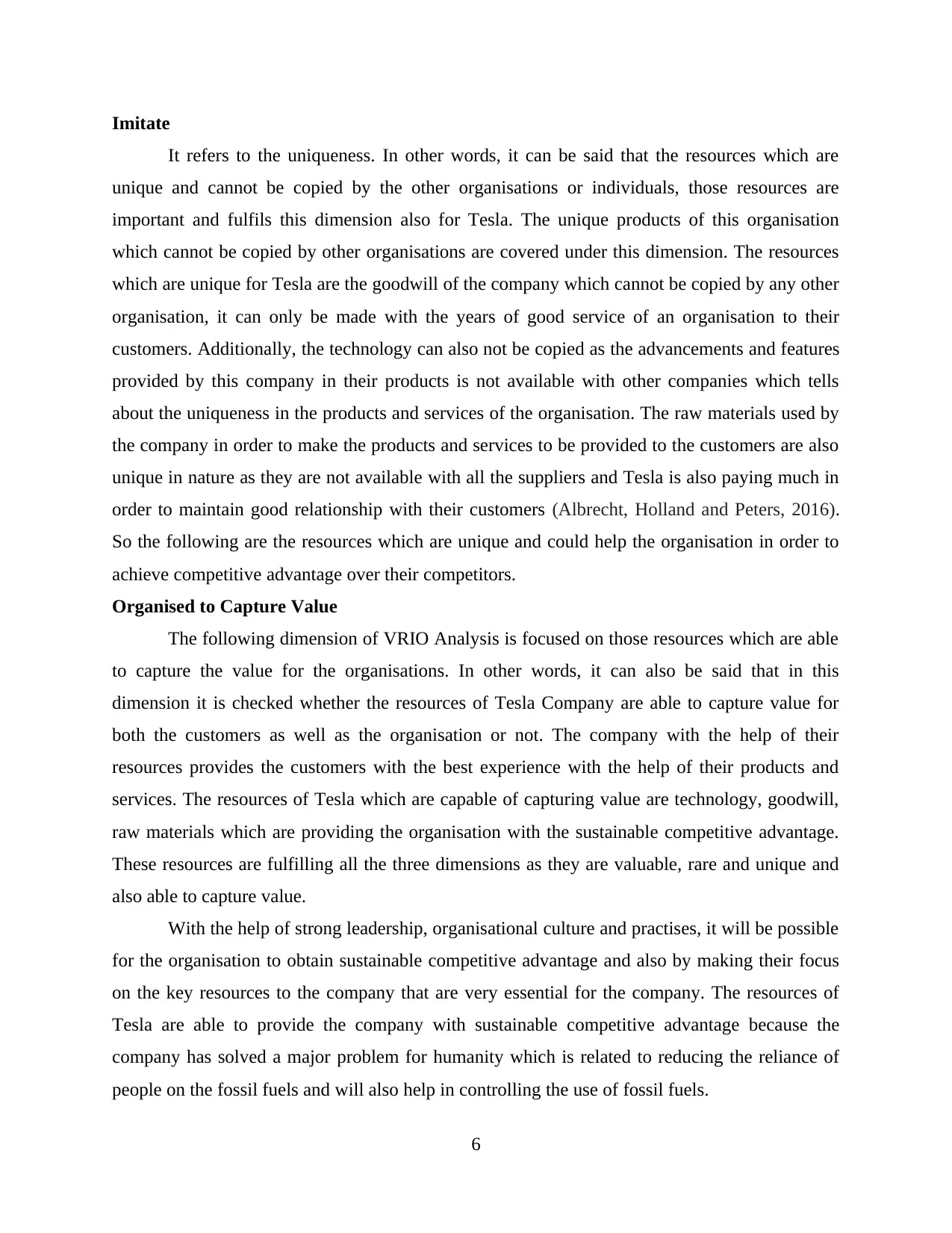
Imitate
It refers to the uniqueness. In other words, it can be said that the resources which are
unique and cannot be copied by the other organisations or individuals, those resources are
important and fulfils this dimension also for Tesla. The unique products of this organisation
which cannot be copied by other organisations are covered under this dimension. The resources
which are unique for Tesla are the goodwill of the company which cannot be copied by any other
organisation, it can only be made with the years of good service of an organisation to their
customers. Additionally, the technology can also not be copied as the advancements and features
provided by this company in their products is not available with other companies which tells
about the uniqueness in the products and services of the organisation. The raw materials used by
the company in order to make the products and services to be provided to the customers are also
unique in nature as they are not available with all the suppliers and Tesla is also paying much in
order to maintain good relationship with their customers (Albrecht, Holland and Peters, 2016).
So the following are the resources which are unique and could help the organisation in order to
achieve competitive advantage over their competitors.
Organised to Capture Value
The following dimension of VRIO Analysis is focused on those resources which are able
to capture the value for the organisations. In other words, it can also be said that in this
dimension it is checked whether the resources of Tesla Company are able to capture value for
both the customers as well as the organisation or not. The company with the help of their
resources provides the customers with the best experience with the help of their products and
services. The resources of Tesla which are capable of capturing value are technology, goodwill,
raw materials which are providing the organisation with the sustainable competitive advantage.
These resources are fulfilling all the three dimensions as they are valuable, rare and unique and
also able to capture value.
With the help of strong leadership, organisational culture and practises, it will be possible
for the organisation to obtain sustainable competitive advantage and also by making their focus
on the key resources to the company that are very essential for the company. The resources of
Tesla are able to provide the company with sustainable competitive advantage because the
company has solved a major problem for humanity which is related to reducing the reliance of
people on the fossil fuels and will also help in controlling the use of fossil fuels.
6
It refers to the uniqueness. In other words, it can be said that the resources which are
unique and cannot be copied by the other organisations or individuals, those resources are
important and fulfils this dimension also for Tesla. The unique products of this organisation
which cannot be copied by other organisations are covered under this dimension. The resources
which are unique for Tesla are the goodwill of the company which cannot be copied by any other
organisation, it can only be made with the years of good service of an organisation to their
customers. Additionally, the technology can also not be copied as the advancements and features
provided by this company in their products is not available with other companies which tells
about the uniqueness in the products and services of the organisation. The raw materials used by
the company in order to make the products and services to be provided to the customers are also
unique in nature as they are not available with all the suppliers and Tesla is also paying much in
order to maintain good relationship with their customers (Albrecht, Holland and Peters, 2016).
So the following are the resources which are unique and could help the organisation in order to
achieve competitive advantage over their competitors.
Organised to Capture Value
The following dimension of VRIO Analysis is focused on those resources which are able
to capture the value for the organisations. In other words, it can also be said that in this
dimension it is checked whether the resources of Tesla Company are able to capture value for
both the customers as well as the organisation or not. The company with the help of their
resources provides the customers with the best experience with the help of their products and
services. The resources of Tesla which are capable of capturing value are technology, goodwill,
raw materials which are providing the organisation with the sustainable competitive advantage.
These resources are fulfilling all the three dimensions as they are valuable, rare and unique and
also able to capture value.
With the help of strong leadership, organisational culture and practises, it will be possible
for the organisation to obtain sustainable competitive advantage and also by making their focus
on the key resources to the company that are very essential for the company. The resources of
Tesla are able to provide the company with sustainable competitive advantage because the
company has solved a major problem for humanity which is related to reducing the reliance of
people on the fossil fuels and will also help in controlling the use of fossil fuels.
6
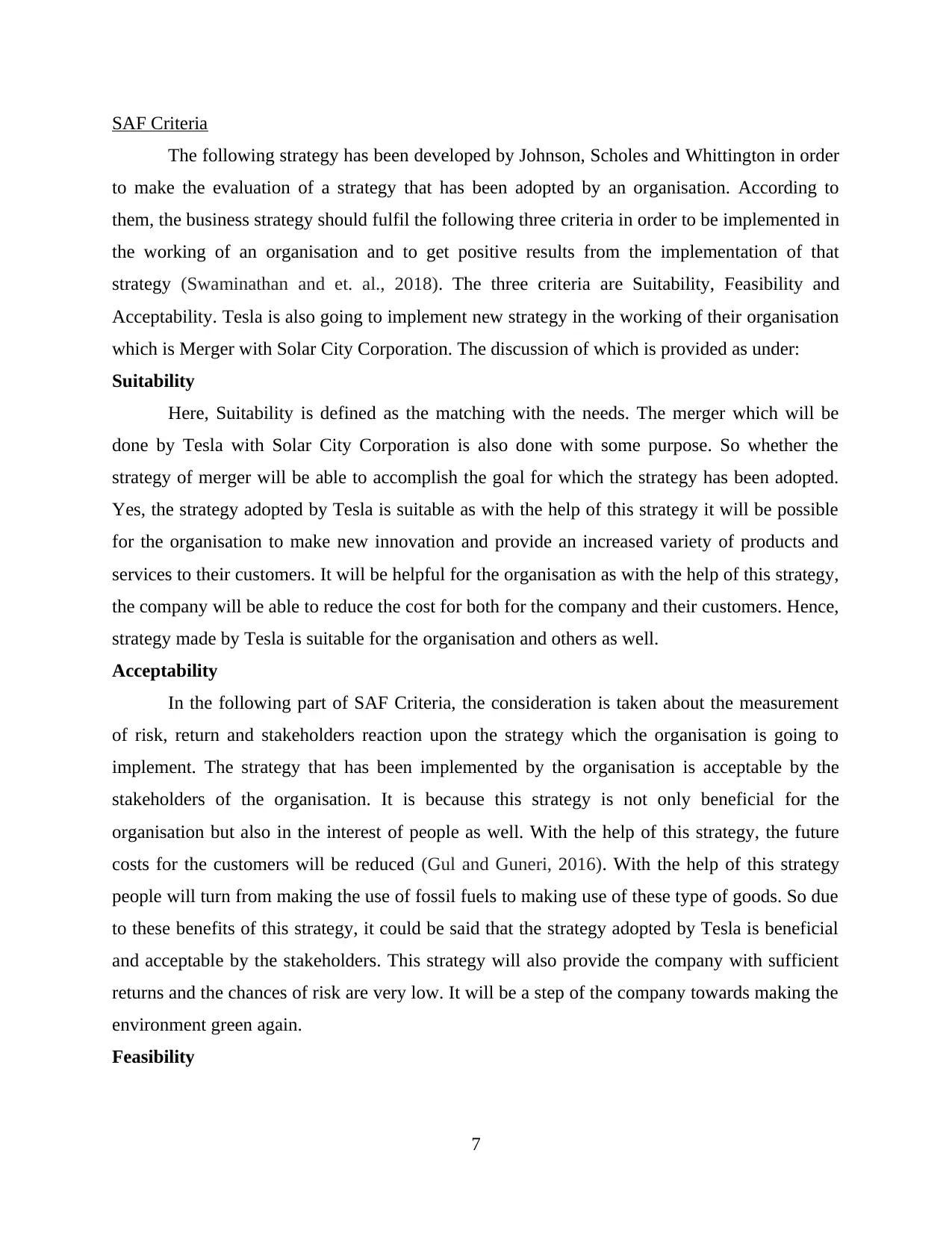
SAF Criteria
The following strategy has been developed by Johnson, Scholes and Whittington in order
to make the evaluation of a strategy that has been adopted by an organisation. According to
them, the business strategy should fulfil the following three criteria in order to be implemented in
the working of an organisation and to get positive results from the implementation of that
strategy (Swaminathan and et. al., 2018). The three criteria are Suitability, Feasibility and
Acceptability. Tesla is also going to implement new strategy in the working of their organisation
which is Merger with Solar City Corporation. The discussion of which is provided as under:
Suitability
Here, Suitability is defined as the matching with the needs. The merger which will be
done by Tesla with Solar City Corporation is also done with some purpose. So whether the
strategy of merger will be able to accomplish the goal for which the strategy has been adopted.
Yes, the strategy adopted by Tesla is suitable as with the help of this strategy it will be possible
for the organisation to make new innovation and provide an increased variety of products and
services to their customers. It will be helpful for the organisation as with the help of this strategy,
the company will be able to reduce the cost for both for the company and their customers. Hence,
strategy made by Tesla is suitable for the organisation and others as well.
Acceptability
In the following part of SAF Criteria, the consideration is taken about the measurement
of risk, return and stakeholders reaction upon the strategy which the organisation is going to
implement. The strategy that has been implemented by the organisation is acceptable by the
stakeholders of the organisation. It is because this strategy is not only beneficial for the
organisation but also in the interest of people as well. With the help of this strategy, the future
costs for the customers will be reduced (Gul and Guneri, 2016). With the help of this strategy
people will turn from making the use of fossil fuels to making use of these type of goods. So due
to these benefits of this strategy, it could be said that the strategy adopted by Tesla is beneficial
and acceptable by the stakeholders. This strategy will also provide the company with sufficient
returns and the chances of risk are very low. It will be a step of the company towards making the
environment green again.
Feasibility
7
The following strategy has been developed by Johnson, Scholes and Whittington in order
to make the evaluation of a strategy that has been adopted by an organisation. According to
them, the business strategy should fulfil the following three criteria in order to be implemented in
the working of an organisation and to get positive results from the implementation of that
strategy (Swaminathan and et. al., 2018). The three criteria are Suitability, Feasibility and
Acceptability. Tesla is also going to implement new strategy in the working of their organisation
which is Merger with Solar City Corporation. The discussion of which is provided as under:
Suitability
Here, Suitability is defined as the matching with the needs. The merger which will be
done by Tesla with Solar City Corporation is also done with some purpose. So whether the
strategy of merger will be able to accomplish the goal for which the strategy has been adopted.
Yes, the strategy adopted by Tesla is suitable as with the help of this strategy it will be possible
for the organisation to make new innovation and provide an increased variety of products and
services to their customers. It will be helpful for the organisation as with the help of this strategy,
the company will be able to reduce the cost for both for the company and their customers. Hence,
strategy made by Tesla is suitable for the organisation and others as well.
Acceptability
In the following part of SAF Criteria, the consideration is taken about the measurement
of risk, return and stakeholders reaction upon the strategy which the organisation is going to
implement. The strategy that has been implemented by the organisation is acceptable by the
stakeholders of the organisation. It is because this strategy is not only beneficial for the
organisation but also in the interest of people as well. With the help of this strategy, the future
costs for the customers will be reduced (Gul and Guneri, 2016). With the help of this strategy
people will turn from making the use of fossil fuels to making use of these type of goods. So due
to these benefits of this strategy, it could be said that the strategy adopted by Tesla is beneficial
and acceptable by the stakeholders. This strategy will also provide the company with sufficient
returns and the chances of risk are very low. It will be a step of the company towards making the
environment green again.
Feasibility
7
⊘ This is a preview!⊘
Do you want full access?
Subscribe today to unlock all pages.

Trusted by 1+ million students worldwide
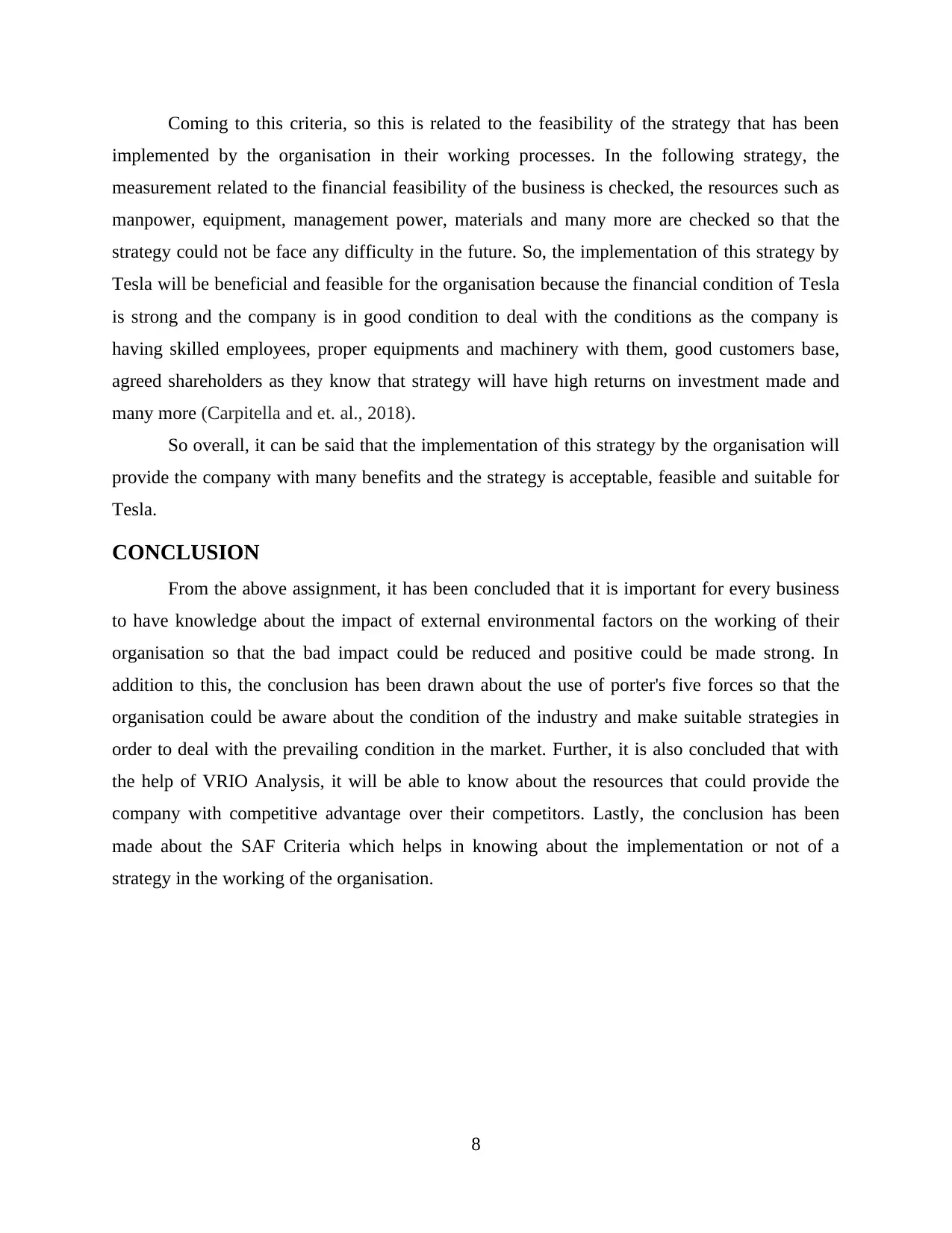
Coming to this criteria, so this is related to the feasibility of the strategy that has been
implemented by the organisation in their working processes. In the following strategy, the
measurement related to the financial feasibility of the business is checked, the resources such as
manpower, equipment, management power, materials and many more are checked so that the
strategy could not be face any difficulty in the future. So, the implementation of this strategy by
Tesla will be beneficial and feasible for the organisation because the financial condition of Tesla
is strong and the company is in good condition to deal with the conditions as the company is
having skilled employees, proper equipments and machinery with them, good customers base,
agreed shareholders as they know that strategy will have high returns on investment made and
many more (Carpitella and et. al., 2018).
So overall, it can be said that the implementation of this strategy by the organisation will
provide the company with many benefits and the strategy is acceptable, feasible and suitable for
Tesla.
CONCLUSION
From the above assignment, it has been concluded that it is important for every business
to have knowledge about the impact of external environmental factors on the working of their
organisation so that the bad impact could be reduced and positive could be made strong. In
addition to this, the conclusion has been drawn about the use of porter's five forces so that the
organisation could be aware about the condition of the industry and make suitable strategies in
order to deal with the prevailing condition in the market. Further, it is also concluded that with
the help of VRIO Analysis, it will be able to know about the resources that could provide the
company with competitive advantage over their competitors. Lastly, the conclusion has been
made about the SAF Criteria which helps in knowing about the implementation or not of a
strategy in the working of the organisation.
8
implemented by the organisation in their working processes. In the following strategy, the
measurement related to the financial feasibility of the business is checked, the resources such as
manpower, equipment, management power, materials and many more are checked so that the
strategy could not be face any difficulty in the future. So, the implementation of this strategy by
Tesla will be beneficial and feasible for the organisation because the financial condition of Tesla
is strong and the company is in good condition to deal with the conditions as the company is
having skilled employees, proper equipments and machinery with them, good customers base,
agreed shareholders as they know that strategy will have high returns on investment made and
many more (Carpitella and et. al., 2018).
So overall, it can be said that the implementation of this strategy by the organisation will
provide the company with many benefits and the strategy is acceptable, feasible and suitable for
Tesla.
CONCLUSION
From the above assignment, it has been concluded that it is important for every business
to have knowledge about the impact of external environmental factors on the working of their
organisation so that the bad impact could be reduced and positive could be made strong. In
addition to this, the conclusion has been drawn about the use of porter's five forces so that the
organisation could be aware about the condition of the industry and make suitable strategies in
order to deal with the prevailing condition in the market. Further, it is also concluded that with
the help of VRIO Analysis, it will be able to know about the resources that could provide the
company with competitive advantage over their competitors. Lastly, the conclusion has been
made about the SAF Criteria which helps in knowing about the implementation or not of a
strategy in the working of the organisation.
8
Paraphrase This Document
Need a fresh take? Get an instant paraphrase of this document with our AI Paraphraser
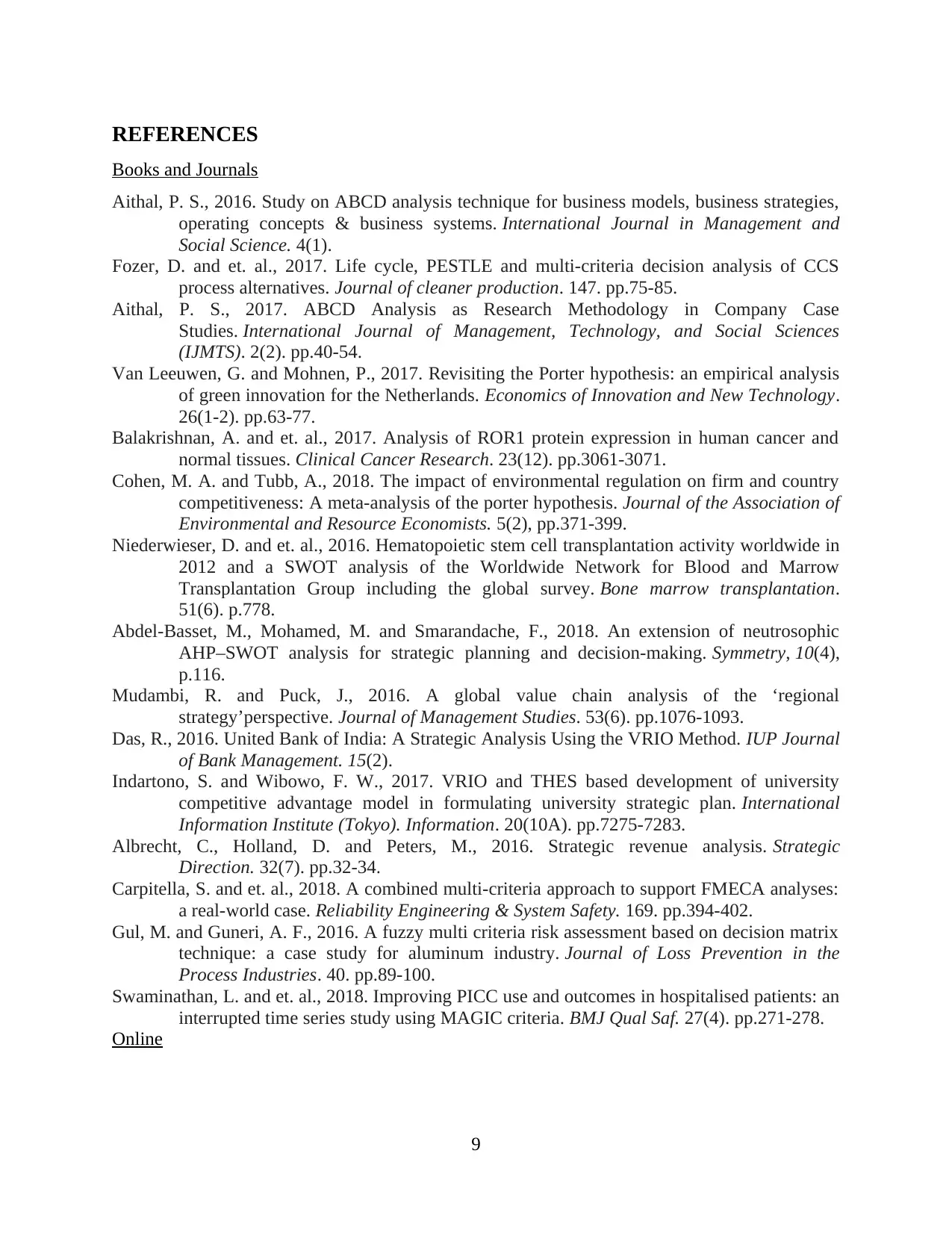
REFERENCES
Books and Journals
Aithal, P. S., 2016. Study on ABCD analysis technique for business models, business strategies,
operating concepts & business systems. International Journal in Management and
Social Science. 4(1).
Fozer, D. and et. al., 2017. Life cycle, PESTLE and multi-criteria decision analysis of CCS
process alternatives. Journal of cleaner production. 147. pp.75-85.
Aithal, P. S., 2017. ABCD Analysis as Research Methodology in Company Case
Studies. International Journal of Management, Technology, and Social Sciences
(IJMTS). 2(2). pp.40-54.
Van Leeuwen, G. and Mohnen, P., 2017. Revisiting the Porter hypothesis: an empirical analysis
of green innovation for the Netherlands. Economics of Innovation and New Technology.
26(1-2). pp.63-77.
Balakrishnan, A. and et. al., 2017. Analysis of ROR1 protein expression in human cancer and
normal tissues. Clinical Cancer Research. 23(12). pp.3061-3071.
Cohen, M. A. and Tubb, A., 2018. The impact of environmental regulation on firm and country
competitiveness: A meta-analysis of the porter hypothesis. Journal of the Association of
Environmental and Resource Economists. 5(2), pp.371-399.
Niederwieser, D. and et. al., 2016. Hematopoietic stem cell transplantation activity worldwide in
2012 and a SWOT analysis of the Worldwide Network for Blood and Marrow
Transplantation Group including the global survey. Bone marrow transplantation.
51(6). p.778.
Abdel-Basset, M., Mohamed, M. and Smarandache, F., 2018. An extension of neutrosophic
AHP–SWOT analysis for strategic planning and decision-making. Symmetry, 10(4),
p.116.
Mudambi, R. and Puck, J., 2016. A global value chain analysis of the ‘regional
strategy’perspective. Journal of Management Studies. 53(6). pp.1076-1093.
Das, R., 2016. United Bank of India: A Strategic Analysis Using the VRIO Method. IUP Journal
of Bank Management. 15(2).
Indartono, S. and Wibowo, F. W., 2017. VRIO and THES based development of university
competitive advantage model in formulating university strategic plan. International
Information Institute (Tokyo). Information. 20(10A). pp.7275-7283.
Albrecht, C., Holland, D. and Peters, M., 2016. Strategic revenue analysis. Strategic
Direction. 32(7). pp.32-34.
Carpitella, S. and et. al., 2018. A combined multi-criteria approach to support FMECA analyses:
a real-world case. Reliability Engineering & System Safety. 169. pp.394-402.
Gul, M. and Guneri, A. F., 2016. A fuzzy multi criteria risk assessment based on decision matrix
technique: a case study for aluminum industry. Journal of Loss Prevention in the
Process Industries. 40. pp.89-100.
Swaminathan, L. and et. al., 2018. Improving PICC use and outcomes in hospitalised patients: an
interrupted time series study using MAGIC criteria. BMJ Qual Saf. 27(4). pp.271-278.
Online
9
Books and Journals
Aithal, P. S., 2016. Study on ABCD analysis technique for business models, business strategies,
operating concepts & business systems. International Journal in Management and
Social Science. 4(1).
Fozer, D. and et. al., 2017. Life cycle, PESTLE and multi-criteria decision analysis of CCS
process alternatives. Journal of cleaner production. 147. pp.75-85.
Aithal, P. S., 2017. ABCD Analysis as Research Methodology in Company Case
Studies. International Journal of Management, Technology, and Social Sciences
(IJMTS). 2(2). pp.40-54.
Van Leeuwen, G. and Mohnen, P., 2017. Revisiting the Porter hypothesis: an empirical analysis
of green innovation for the Netherlands. Economics of Innovation and New Technology.
26(1-2). pp.63-77.
Balakrishnan, A. and et. al., 2017. Analysis of ROR1 protein expression in human cancer and
normal tissues. Clinical Cancer Research. 23(12). pp.3061-3071.
Cohen, M. A. and Tubb, A., 2018. The impact of environmental regulation on firm and country
competitiveness: A meta-analysis of the porter hypothesis. Journal of the Association of
Environmental and Resource Economists. 5(2), pp.371-399.
Niederwieser, D. and et. al., 2016. Hematopoietic stem cell transplantation activity worldwide in
2012 and a SWOT analysis of the Worldwide Network for Blood and Marrow
Transplantation Group including the global survey. Bone marrow transplantation.
51(6). p.778.
Abdel-Basset, M., Mohamed, M. and Smarandache, F., 2018. An extension of neutrosophic
AHP–SWOT analysis for strategic planning and decision-making. Symmetry, 10(4),
p.116.
Mudambi, R. and Puck, J., 2016. A global value chain analysis of the ‘regional
strategy’perspective. Journal of Management Studies. 53(6). pp.1076-1093.
Das, R., 2016. United Bank of India: A Strategic Analysis Using the VRIO Method. IUP Journal
of Bank Management. 15(2).
Indartono, S. and Wibowo, F. W., 2017. VRIO and THES based development of university
competitive advantage model in formulating university strategic plan. International
Information Institute (Tokyo). Information. 20(10A). pp.7275-7283.
Albrecht, C., Holland, D. and Peters, M., 2016. Strategic revenue analysis. Strategic
Direction. 32(7). pp.32-34.
Carpitella, S. and et. al., 2018. A combined multi-criteria approach to support FMECA analyses:
a real-world case. Reliability Engineering & System Safety. 169. pp.394-402.
Gul, M. and Guneri, A. F., 2016. A fuzzy multi criteria risk assessment based on decision matrix
technique: a case study for aluminum industry. Journal of Loss Prevention in the
Process Industries. 40. pp.89-100.
Swaminathan, L. and et. al., 2018. Improving PICC use and outcomes in hospitalised patients: an
interrupted time series study using MAGIC criteria. BMJ Qual Saf. 27(4). pp.271-278.
Online
9
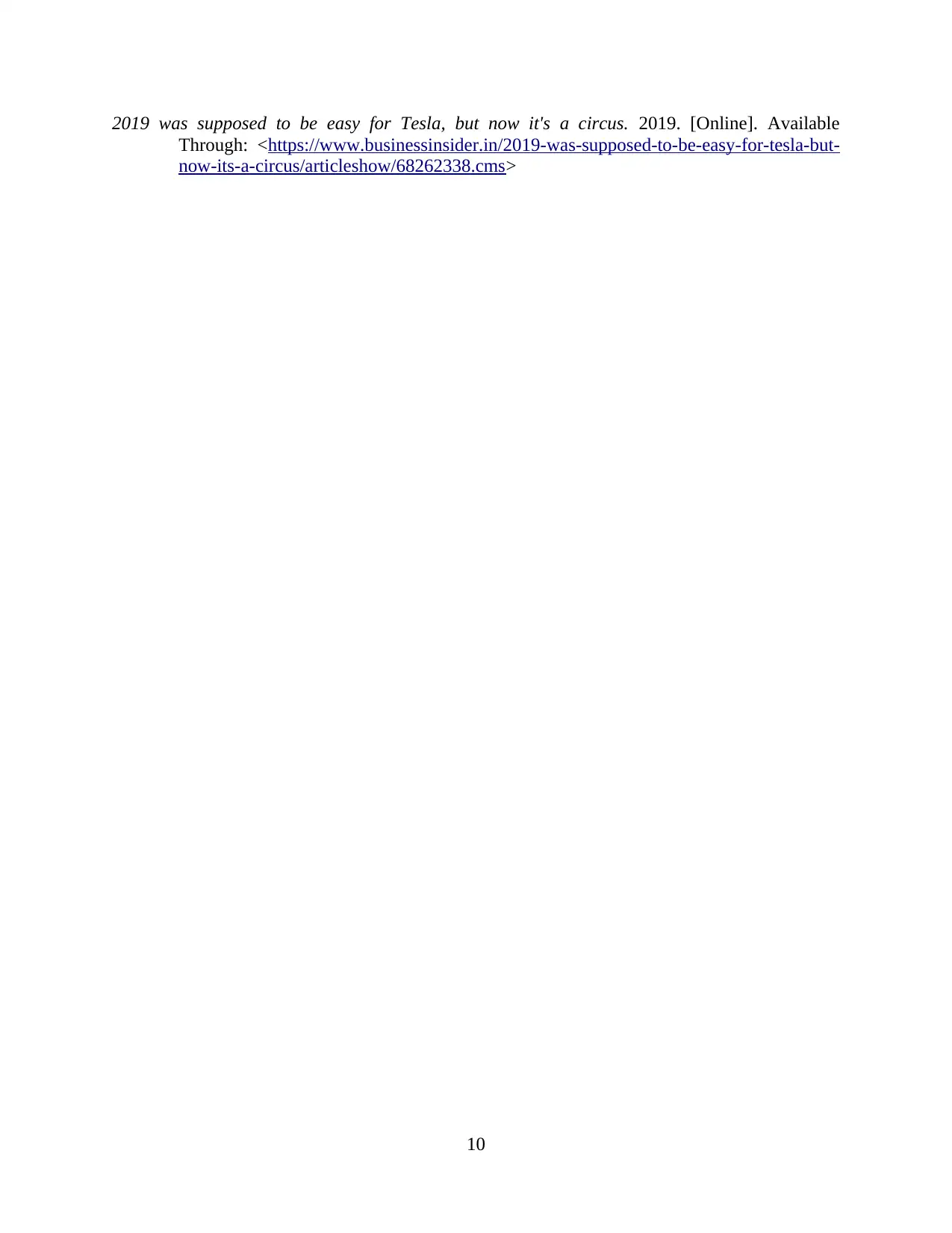
2019 was supposed to be easy for Tesla, but now it's a circus. 2019. [Online]. Available
Through: <https://www.businessinsider.in/2019-was-supposed-to-be-easy-for-tesla-but-
now-its-a-circus/articleshow/68262338.cms>
10
Through: <https://www.businessinsider.in/2019-was-supposed-to-be-easy-for-tesla-but-
now-its-a-circus/articleshow/68262338.cms>
10
⊘ This is a preview!⊘
Do you want full access?
Subscribe today to unlock all pages.

Trusted by 1+ million students worldwide
1 out of 12
Related Documents
Your All-in-One AI-Powered Toolkit for Academic Success.
+13062052269
info@desklib.com
Available 24*7 on WhatsApp / Email
![[object Object]](/_next/static/media/star-bottom.7253800d.svg)
Unlock your academic potential
Copyright © 2020–2025 A2Z Services. All Rights Reserved. Developed and managed by ZUCOL.





